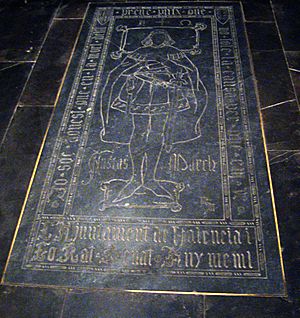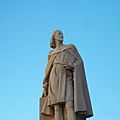Ausiàs March facts for kids
Quick facts for kids
Ausiàs March
|
|
|---|---|

|
|
| Born | 1400 Beniarjó, Kingdom of Valencia (Crown of Aragon) |
| Died | 1459 València, Kingdom of Valencia (Crown of Aragon) |
| Occupation | Poet and knight |
| Language | Valencian language |
| Notable works | Plena de Seny, Llir entre Cards, Amor, amor, Mon darrer bé, Oh, foll amor |
| Spouse |
Isabel Martorell
(m. 1439–1441)Joana Escorna
(m. 1443–1450) |
| Relatives |
|
Ausiàs March (pronounced aw-zee-AHS MARK; 1400 – March 3, 1459) was an important poet and knight from the Middle Ages. He lived in Gandia, which is in Valencia.
Ausiàs March wrote his poems in the Valencian language. He is known as one of the most important poets of the "Golden Century" (Segle d'or). This was a special time for literature in the Catalan and Valencian languages.
About Ausiàs March
Not a lot is known about Ausiàs March's daily life. He was born around the year 1400 into a noble family from Valencia. A noble family is one with a high social rank.
His father, Pere March, was also a poet. He worked for Prince Peter, who was the younger brother of King Alfonso IV. Ausiàs March's uncle, Jaume March II, was also a poet. Ausiàs had a younger sister named Peirona.
When Ausiàs was still young, in 1413, his father passed away. This meant Ausiàs became the head of his family. His family was part of the "petty nobility," which means they were nobles but not as powerful as kings or dukes.
From a young age, Ausiàs March joined King Alfons el Magnànim on military trips. These trips took place across the Mediterranean Sea. After these journeys, he returned home in 1427 and settled in Gandia. He never left his home region again after that.
Ausiàs March was married two times. His first wife was Isabel Martorell, who was the sister of another famous writer, Joanot Martorell. Later, he married Joana Escorna.
In 1450, he moved from Gandia to Valencia. He passed away there on March 3, 1459. Ausiàs March was buried in his family's special chapel at the Valencia Cathedral. His two wives and other family members are buried at the Monastery of Sant Jeroni de Cotalba. He had several children.
Ausiàs March's Poetry

Ausiàs March was lucky to inherit money from his father. His father, Pere March, was the treasurer for the Duke of Gandia. Ausiàs also had strong support from Charles of Viana, who was a prince. Because of this, Ausiàs could spend his time writing poems.
He was a big admirer of another famous poet named Petrarch. Ausiàs March even wrote his "love songs" (called Cants d'amor) to a lady he said he first saw in church. He tried to copy Petrarch's rhythm in his poems. However, Ausiàs March was also very original and unique in his writing.
In his "death hymns" (called Cants de mort), he wrote about deep and personal feelings. He explored emotions in a way that was special to him. He used Petrarch's style but made it his own, focusing on inner thoughts and feelings. Other great poets like Camões and Shakespeare would later do similar things.
Ausiàs March was one of the first poets to use his local language, Valencian, for his poems. Before him, many poets used a language called Occitan, which was common for troubadours (singing poets).
His poems can sometimes be a bit mysterious. They often talk about sadness and the struggle between what someone desires and what they know is right. His poem Cant Spiritual shows this conflict very well.
Ausiàs March was considered the best poet of his time. His new way of writing helped other poets. For example, Boscán was encouraged to bring Italian poetry styles into the Castilian language.
Ausiàs March's poems were first shared as handwritten copies. The first printed version in Valencian came out in 1543. But his poems were already known because they had been translated into Spanish in 1539.
Many of Ausiàs March's poems have been turned into songs. Musicians like Raimon and Joan Brudieu have set his words to music.
Images for kids
See also
 In Spanish: Ausiàs March para niños
In Spanish: Ausiàs March para niños





